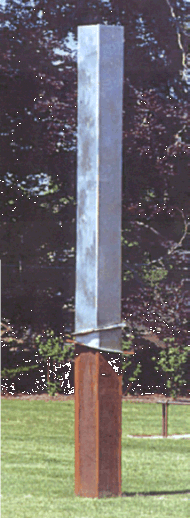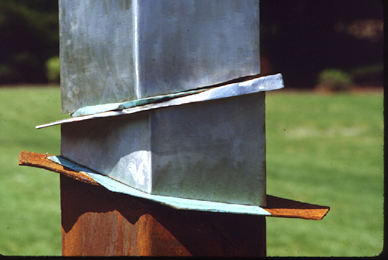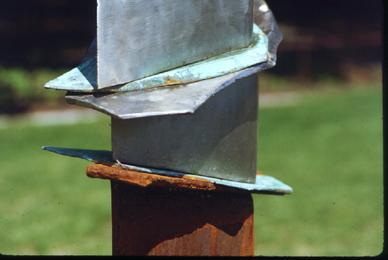Column 2
These pieces, like all my work, use the phenomena of ice as a metaphorical point of departure; it is to be emphasized that this is only a point of departure– a work of visual art too closely reasoned is bound to lack ambiguity, breath, and life. In these, the ice referred to is continental ice sheets such as found in Greenland and Antarctica. The sculptures can be seen as slices through the strata of rock and ice, which can be miles thick and 500,000 years old, or more. More Information
The science on this dating is evolving rapidly. In many pieces in this series, the ‘slices’ refer to drilled ice cores, that when analyzed are one of our main sources of climate information, regarding present, past, and by implication future conditions. These cores are archived in libraries, but they are among the most fragile ones on earth. A brief failure of freezer technology and the precious and irreplaceable tomes turn into puddles. Metaphorically, it is important to know that under the seemingly invulnerable and solid continentally sized masses is a boundary layer of slush and water, due to heat from the earth and compression. Occasionally, water can seep away, leaving voids and caves. This boundary layer acts as a lubricant, leading to instability and vulnerability of the whole: vast sections are at risk of sliding off into the sea, and any ice that does so will have a short life. Others of this series trace their intellectual roots to the huge crevasses that lurk under the surface of the seemingly solid ice, and that have claimed many lives both human and animal, and their gear, by falling through the thin snow roof that concealed their presence. Again, the thrust of the thinking relates to the tension between the apparent solidity, and actual precarious reality. There are certain parallels with our species, which flatters itself on its ‘dominance’. Despite such appearances, under the surface are characteristics that render our long term survival neither preordained, nor perhaps even desirable.
***********
The Greek root word is ‘piester’, a noun meaning ‘press’ , as in printing press. This derives from the verb ‘piezo’, to press. These concepts exist in english, for example in ‘piezoelectric’– a phonograph needle is a piezoelectric crystal. The ‘-ion’ suffix indicates ‘place of’. The connection to ice cores and the volumes of data extracted from them should be evident.: snow to firn to ice, via pressure.


